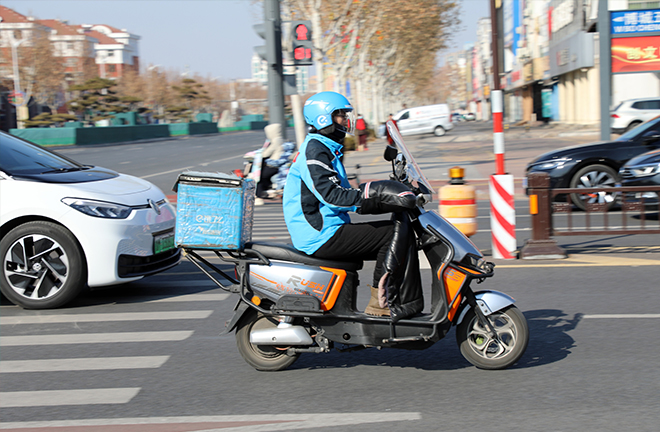Delivery workers enjoy autonomy within algorithmic constraints

A delivery worker in Boxing County, Binzhou City, Shandong Province Photo: IC PHOTO
There is a common perception that algorithms exert absolute control over delivery workers, but the relationship between algorithms and platform labor is far from a one-way dynamic of control and subjugation. Delivery workers’ autonomy and professional skills remain critical components of their work. Throughout their shifts, delivery workers navigate complex, constantly changing environments such as shopping malls, supermarkets, streets, and residential communities. They must continuously manage interactions with merchants, consumers, security personnel, and others. Those adept at “cultivating the system” are able to discern algorithmic patterns, make swift, informed decisions, and effectively coordinate their relationships with various stakeholders. This ability enhances their delivery efficiency, leading to increased earnings.
Food delivery ecosystem
The food delivery platform functions as an ecosystem connecting consumers, merchants, and delivery workers, each of whom has distinct interests and takes corresponding actions to achieve them. Delivery workers aim to maximize earnings by completing as many orders as possible within a limited timeframe while minimizing travel distances. To do so, they prefer to receive multiple orders along similar routes, allowing them to consolidate deliveries and improve efficiency. From the merchants’ perspective, the quality of food deteriorates as time passes after it leaves the kitchen, which can negatively impact customer satisfaction and repeat business. Thus, merchants prefer that delivery workers pick up meals immediately upon preparation and ensure timely delivery to maintain food quality. Consumers, on the other hand, expect to receive their orders as quickly as possible after placing them. Given these competing interests, the algorithm plays a central role in balancing the priorities of all the three parties. When dispatching orders, it seeks to provide an optimized solution that addresses the needs of all parties.
When a customer places and pays for an order, the system immediately notifies the restaurant to begin meal preparation. Almost simultaneously, the restaurant dispatches the order to nearby delivery workers through the scheduling system. The algorithm evaluates each delivery worker’s current location and workload, estimating the time required and route efficiency for potential recipients. It then assigns the order to the worker best positioned—both in terms of proximity and schedule flexibility—to complete the delivery efficiently, allowing them to maximize earnings without excessive labor. Delivery workers, however, retain the ability to reject or transfer orders and can adjust their order intake in the app at any time. For newcomers, the algorithm offers a degree of leniency, prioritizing shorter, simpler deliveries that are easier to manage.
‘Human-machine conflicts’
Despite its sophistication, the algorithm is far from flawless and cannot cater to every delivery worker’s needs, leading to occasional “human-machine conflicts.”
New delivery workers, in particular, often find themselves working harder yet completing fewer orders, which can lead to their frustration with the system. This issue arises primarily from two limitations. First, algorithms lack localized social knowledge. They cannot access all real-world data or keep up with its dynamic changes in real time. For example, algorithms struggle to fully account for the layout of roads, buildings, parks, and overpasses in different cities, and they often miss updates on traffic restrictions, temporary roadworks, or sudden closures. These gaps can cause inefficient route planning, leading delivery workers to take unnecessary detours and expend effort on avoidable tasks. Moreover, digital technology is ill-equipped to anticipate and guide delivery workers through unexpected incidents and interpersonal interactions. During pickups and deliveries, workers frequently shift between diverse environments—restaurants, residential complexes, office buildings, and busy streets—and encounter a wide range of people and unforeseen situations. Algorithms cannot offer real-time advice on navigating these human factors, nor can they adjust delivery routes promptly to accommodate sudden disruptions.
On the other hand, delivery workers have diverse interests and varying preferences for orders and routes, making it difficult for the algorithm to satisfy everyone. From the algorithm’s perspective, all orders are equal—there is no distinction between good and bad. However, some delivery workers prefer long-distance deliveries, while others favor shorter routes. Some, facing financial pressures, seek a steady flow of orders, whereas others prefer fewer assignments to reduce workload. Each worker evaluates orders based on their personal priorities and delivery preferences.
‘Cultivating the system’
To secure stable income and more desirable orders, and ultimately maximize personal benefits, delivery workers need to “cultivate the system” through skillful engagement.
Delivery work is inherently unpredictable, both due to the complex nature of the delivery process—interacting with various people and navigating dynamic environments—and the algorithm’s unpredictable assignment of order quantity and quality. Professional skills help mitigate these uncertainties. Experienced delivery workers not only leverage their expertise to streamline deliveries and complete tasks efficiently and reliably but also learn how to cultivate the algorithmic system. By engaging with the algorithm—training it through consistent behavioral patterns and offering feedback—they can influence the system to improve working conditions for themselves and their peers.
From an individual standpoint, system cultivation involves using professional skills to interact with the algorithm’s learning mechanisms, intentionally generating behavioral data to fine-tune how the system assigns orders. The goal is to reduce uncertainties in both the number and type of orders received. The effectiveness of this strategy depends on factors such as workers’ delivery practices, their understanding of the algorithm, and their behavioral preferences. Over time, delivery workers develop personalized strategies for cultivating the system, leading to more consistent income, greater job stability, and expanded opportunities on the platform.
The widespread adoption of system cultivation strategies demonstrates that delivery workers are not passively controlled by algorithms. Instead, they maintain a degree of autonomy within the labor process. This underscores the need for platforms to respect workers’ expertise and choices, and foster a more open and diversified system of algorithmic communication. By continuously refining algorithmic capabilities and improving the work experience, platforms can ensure that technology serves the people, aligning with ethical principles that prioritize human wellbeing.
Li Jiwei is executive director of the Meituan Research Institute.
Edited by CHEN MIRONG
